Overview of educational sets for electronics for children (7+)

An interesting and accessible educational kit on electronics for children is probably the dream of any parent who wants to captivate a child with something “real”.
The direction of popularizing technical creativity among children was among the interests of our hackspace, and since our inception (3 years ago) we have been following the situation in this area - and during this time several interesting educational kits for children have appeared on the Russian market.
')
We took for review sets based on development boards, which provides a quick start - it allows you to get a working scheme without the need for soldering, the developers of sets are Russian companies, and the target age is from 7 years.
The review will include three sets, from the companies of Amperk , Cyber Physics and Master-Kit :
- Children's electronic designer Amperka Micronic
- Cyber Physics. Basics of electronics. Start
- Constructor Master-Kit NR03, Alphabet of the Electronic Engineer - Basics of Circuitry
We provided these kits to a hackspace participant, and he and his brother (7 years old) made TestDrive all the kits, and this is a first-person story:
Hello! My name is Anton and I want to tell you how from a good colleague for the review I got three sets for teaching electronics and circuitry.
A little about me: 25 years old, diploma IT engineer. Knowledge in electronics ends with a university course. Sometimes I hold a soldering iron in my hands (mainly to solder the wires), I know why this or that element is needed, if I remember or find the formula, I can count something for the circuit.
Brother, 7 years old, studying in first grade. He likes to play designers, but does not like to collect himself. He is interested in computers, phones, tablets and other modern things.
Micronik set
So, the first set, which I considered, was Mikronik. It so happened that I started collecting it alone. I was greeted by a neat-looking box, inside which lay neatly laid out sachets of elements and a brochure with diagrams. Before that, I read reviews of sets from Ampere (and even worked with one such), and therefore the performance seemed to me very similar. And for good reason, it really turned out to be a set from Ampere. The brochure is very colorful, everything is painted with a soul, it is understandable enough, although I would not be against conceptual schemes and a bit of theory.


Having laid out all the sachets on the table and opened the brochure, I began to collect the schemes. Grieved the lack of batteries in the kit, because At home, it is not always possible to find three finger batteries. The terminal block also turned out to be quite capricious - it was necessary to clean the wires additionally, but it still turned out to be difficult to mount them inside the terminal block. Getting the terminal strip from the breadboard was not very convenient, so every time I was tormented by disconnecting one of the power wires.
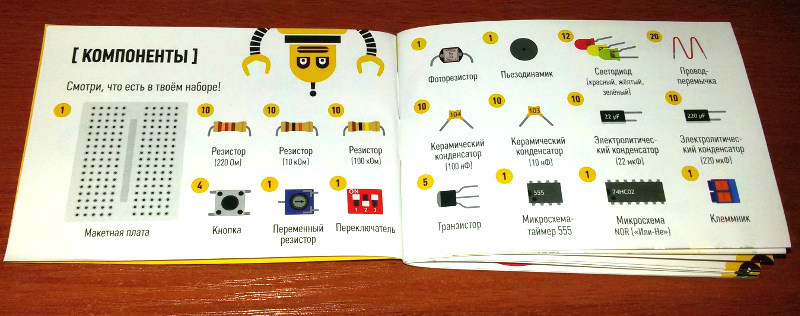

The breadboard itself turned out to be small, and the jumpers were big. There were no problems with the assembly of the first schemes, although from time to time it was necessary to correct and rearrange the elements, since there was no contact with the breadboard. Having reached the scheme with the timer 555, I ran into unexpected difficulties. The assembled circuit did not work. About 20 minutes spent on a careful study of the scheme, reassembled it twice from scratch. And, finally, after the next time, when he moved all the elements - the scheme began to work as it should.
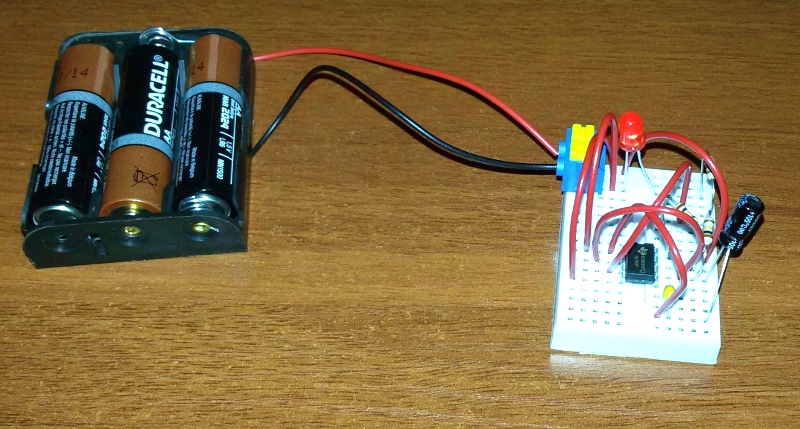
Another unpleasant feature that arose when the kit was assembled back - folding all the bags turned out to be inconvenient. Little space, the lid of the box with difficulty closed.
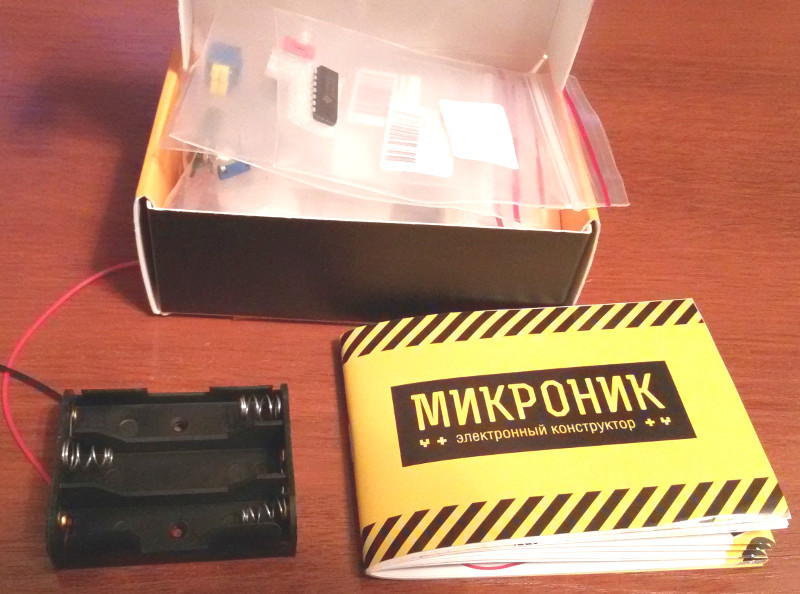
In general, the impressions were positive - judging by the price tags, the set is the most inexpensive, and on the whole it justifies its price - everything is arranged in bags, everything is signed, the brochure is clear and colorful, but the prototype board seemed to me too small and the feeling that the elements in the layout keep bad, because sometimes I had to correct them in order to make contact.
List of micronik recruitment projects
Lamp
Multicolored lights
Barrel with electricity
Telegraph
Dimmer
Traffic light
Stupid lamp
Magic fingers
Code lock
Lighthouse
Smart light
Stroboscope
Railway experiment
Horn
Theremin
Signaling
Almost piano
Timer
Corridor switch
Duck hunting
Multicolored lights
Barrel with electricity
Telegraph
Dimmer
Traffic light
Stupid lamp
Magic fingers
Code lock
Lighthouse
Smart light
Stroboscope
Railway experiment
Horn
Theremin
Signaling
Almost piano
Timer
Corridor switch
Duck hunting
Set "Cyber Physics"
On the second day my brother joined to work with the set. We were met by a large colorful box with a bunch of smaller boxes inside. While I was looking at a small brochure, I went through the boxes - everything was neatly laid out, everything was signed, all in separate sachets. I noticed that the elements are laid out in boxes for a reason: resistors are separate, semiconductors are separate, capacitors are separately, and so on.



The brochure turned out to be quite informative, there is a list of elements necessary for assembling each circuit, a schematic diagram and a circuit for assembling on a breadboard. My brother quickly realized that he needed to see what elements were needed for the scheme, and get the necessary elements from the corresponding bag.
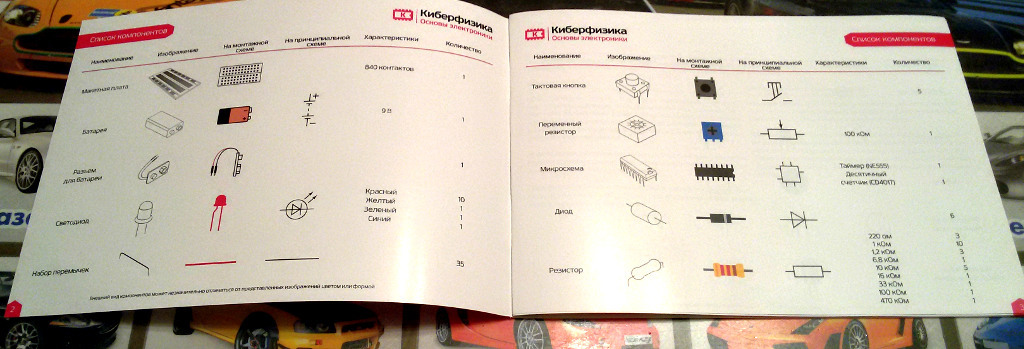

I was pleased with the size of the breadboard - a lot of space for creativity. I assembled the first circuit with one LED, then my brother added other LEDs by analogy. With a little help of my collected other schemes.

The next day, the brother himself calmly collected various shemki, except sometimes he asked for help when he missed the conclusions of the elements. For the first day, half of the schemes were collected, and I thought that it would be necessary to search the Internet for more simple schemes for the future
Only positive impressions remained from the set - everything was done at a high level, it is understandable even to a child. Among the shortcomings, I can single out a relatively high price (compared to Mikronik), but if you look at the prices of the elements separately and the price of the corresponding teaching materials, then the question disappears - the price becomes quite adequate.
List of Cyber Physics Projects Basics of Electronics
The very first scheme. Power Indicator.
Light Morse Code.
Push-button traffic lights.
Soft subdued light. Dimmer or dimmer switch. Potentiometer.
Stupid fixture. Photoresistor.
Piggy bank for electric charge. Capacitor.
Human guide Bipolar transistor.
Security alarm on a single transistor.
Obstinate light. RC chain.
Automatic night light.
Symmetric Multivibrator with two transistors
Acquaintance with the most popular microcircuit - timer 555. Building a mock-up of a traffic light at a railway crossing.
Luminous theremin. Active buzzer.
Metronome on the NE555 microcircuit.
Push light. Chip - CD4017 ring counter.
Running on the spot. Automatic "Running light".
Police flasher. Blue and red LEDs alternately flash quickly three times, like a real flashing light on a police car.
LED Roulette. Almost like a casino.
Model code lock.
Light Morse Code.
Push-button traffic lights.
Soft subdued light. Dimmer or dimmer switch. Potentiometer.
Stupid fixture. Photoresistor.
Piggy bank for electric charge. Capacitor.
Human guide Bipolar transistor.
Security alarm on a single transistor.
Obstinate light. RC chain.
Automatic night light.
Symmetric Multivibrator with two transistors
Acquaintance with the most popular microcircuit - timer 555. Building a mock-up of a traffic light at a railway crossing.
Luminous theremin. Active buzzer.
Metronome on the NE555 microcircuit.
Push light. Chip - CD4017 ring counter.
Running on the spot. Automatic "Running light".
Police flasher. Blue and red LEDs alternately flash quickly three times, like a real flashing light on a police car.
LED Roulette. Almost like a casino.
Model code lock.
Masterkit set
On the third day we decided to see what kind of set we represent Masterkit. It is also a fairly large box with the design in the spirit of school textbooks. Inside there was a brochure, a breadboard, a battery and ... one bag with a scattering of elements.
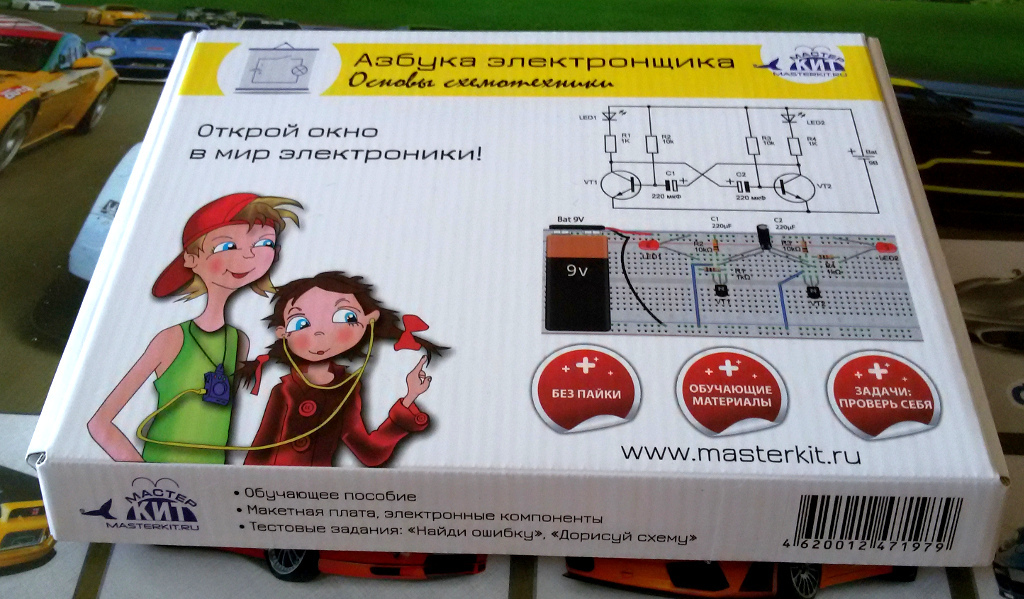
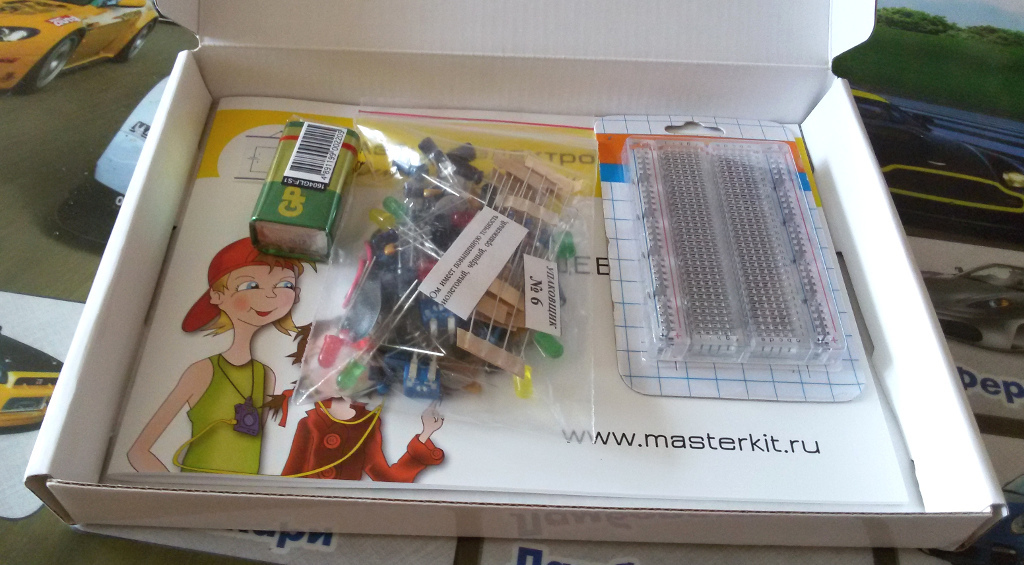
I personally liked the theoretical part in the brochure. Here both formulas for calculating the resistance, and formulas for calculating the capacitance of capacitors and the presentation of the theory personally seemed to me more understandable and pleasant.


I was not very pleased with the battery connection box - after dialing Cyberphysics, connecting the wires turned out to be very inconvenient - every now and then they tried to bend and not get inside the layout. It felt that elements were inserted better into the prototyping board itself, but transparent plastic was not very practical compared to white - it’s hard to see where the element is connected. It also seemed strange to connect the battery to the breadboard board in the diagrams - we connect the positive contact to the negative bus. Brother also had to explain that the designation of tires "+" and "-" only for convenience.
The schemes described in the brochure are basically identical, except that an infrared sensor was added, which added interest.
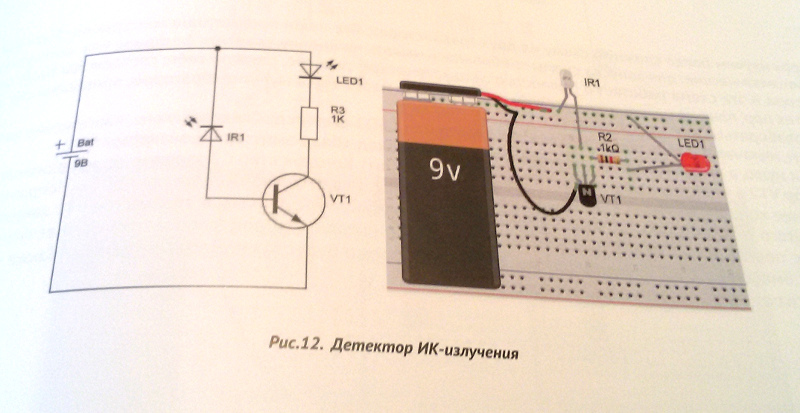

In the set I liked the brochure with the theoretical part and the language of presentation, but all the advantages covered the following disadvantages:
- packing of all elements in one bag
- a bit strange power wiring diagrams
- a bad block for connecting the battery to the breadboard
findings
Since the goal was to compare the three sets, it is more convenient to present them in the table:
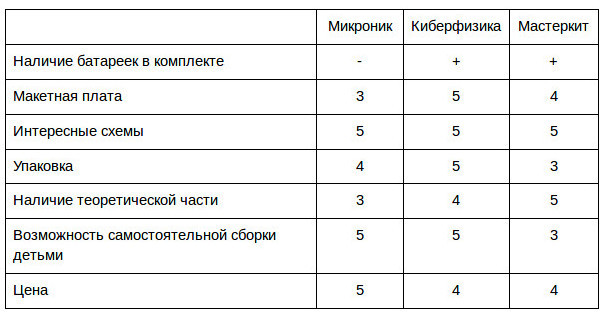
So I would prefer to start Cyber Physics, for starting electronics and circuitry, it has everything you need to get started and there is the potential for further study of the schemes yourself. But other kits may also be interested in electronics.
Prices and where to buy (UPD: price for 12.2017)
Source: https://habr.com/ru/post/370197/
All Articles